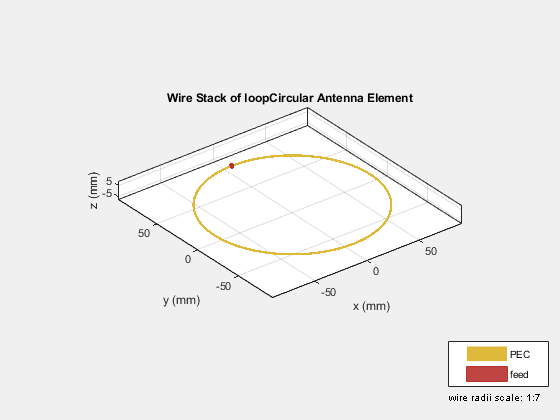wireStack
Create single or multi-feed wire antenna
Description
The wireStack object converts eligible dipole and loop
antennas in the Antenna Catalog to wire antennas with single or multiple
feeds. You can now create cylindrical thin-wire antennas and analyze them using the
existing analysis functions.
Note
For some antennas, the wire geometry may be altered to allow the placement of the
feed. Use the show function to view the
resulting antenna and verify its shape before running any analysis.
Creation
Description
ant = wireStack
ant = wireStack(element)strip2cylinder utility function.
Input Arguments
Output Arguments
Properties
Object Functions
axialRatio | Calculate and plot axial ratio of antenna or array |
beamwidth | Beamwidth of antenna |
charge | Charge distribution on antenna or array surface |
current | Current distribution on antenna or array surface |
EHfields | Electric and magnetic fields of antennas or embedded electric and magnetic fields of antenna element in arrays |
feedCurrent | Calculate current at feed for antenna or array |
impedance | Calculate and plot input impedance of antenna or scan impedance of array |
info | Display information about antenna, array, or platform |
memoryEstimate | Estimate memory required to solve antenna or array mesh |
mesh | Generate and view mesh for antennas, arrays, and custom shapes |
meshconfig | Change meshing mode of antenna, array, custom antenna, custom array, or custom geometry |
pattern | Plot radiation pattern of antenna, array, or embedded element of array |
patternAzimuth | Azimuth plane radiation pattern of antenna or array |
patternElevation | Elevation plane radiation pattern of antenna or array |
returnLoss | Calculate and plot return loss of antenna or scan return loss of array |
show | Display antenna, array structures, shapes, or platform |
sparameters | Calculate S-parameters for antenna or array |
vswr | Calculate and plot voltage standing wave ratio (VSWR) of antenna or array element |
Examples
Version History
Introduced in R2020a
See Also
loopCircular | strip2cylinder | dipole | dipoleFolded | dipoleMeander | dipoleVee | dipoleHelix | dipoleJ | dipoleCycloid | dipoleCrossed | loopRectangular



